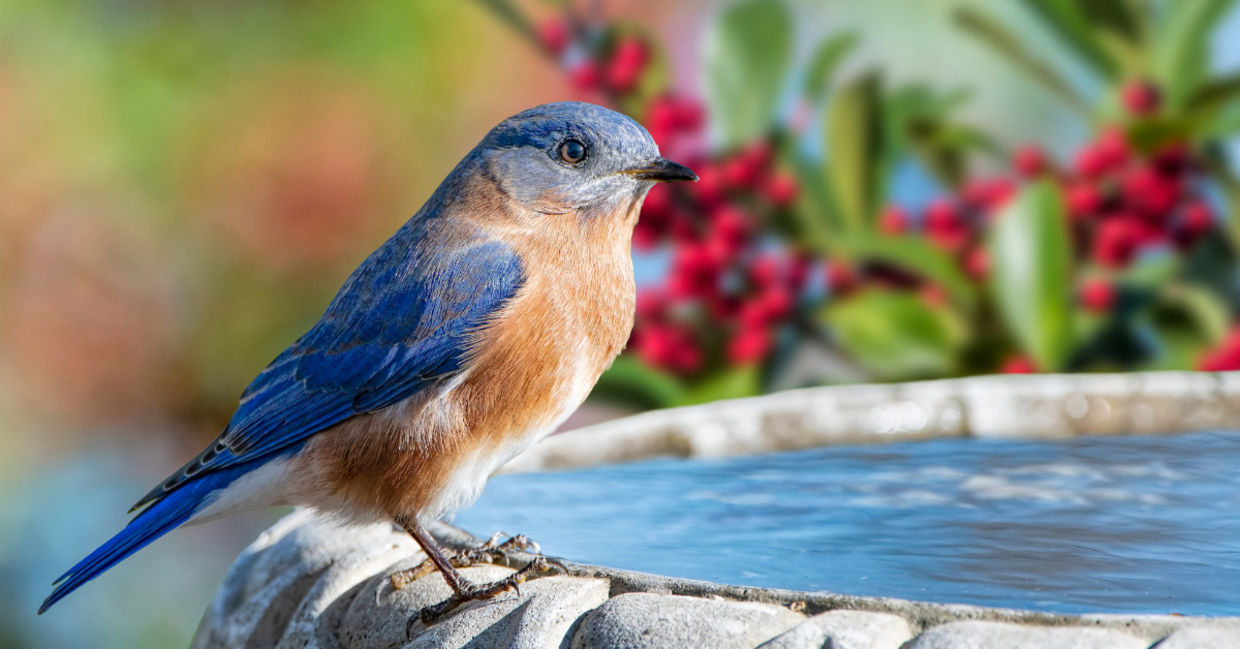
(Bonnie Taylor Barry / Shutterstock.com)
It’s summer and the weather is hot. Vacationers pack the beaches and pools, looking to beat the heat, while lemonade stands, hydration stations, and ice cream trucks offer relief to parched parkgoers. Urban birds and bugs also seek hydrating summer oases. Many visit backyards and gardens looking for cool, sweet, and refreshing water sources. Why not help them out this summer by setting up an urban wildlife hydration station – also known as a birdbath?
Urban wildlife flocks to birdbaths
A study published in Urban Ecosystems reveals the role that birdbaths and other backyard water sources play in keeping urban wildlife hydrated. According to Phys.org, researchers used online questionnaires and field observations to track how frequently wildlife “vacationed” at garden water sources in Hertfordshire, England.
Nearly three-quarters of survey respondents reported that they had water sources in their backyards, including ponds, birdbaths, and ground water-bowls. Field researchers spent 135 hours observing at a dozen of these backyard gardens, and 72 hours watching wildlife at natural lakes.
Findings revealed that 43 species of urban wildlife, including exotic birds, mammals, reptiles, amphibians, and insects, showed no preference for natural lakes over garden “hydration stations.” The results demonstrated just how important birdbaths and other backyard water sources could be to local fauna.
Dr. Nicola Rooney, one of the paper’s authors summed up the study. “These results demonstrate garden water sources, especially for smaller-bodied animals, can supplement the wildlife values contributed by urban lakes, particularly during periods of hot, dry weather,” he told Phys.org.
Three tips for setting up a backyard birdbath
For homeowners looking to keep their feathered neighbors cool and refreshed this summer, setting up and maintaining a backyard birdbath is not difficult. And, not only does it benefit local wildlife, but birdbaths come in a number of gorgeous and classy designs that can upgrade a garden’s aesthetic. The NYT reports that watching birds splash about is similarly gratifying.
Choose bird-friendly materials
Concrete makes for a sturdy, bird-friendly bath surface. Plastic birdbaths can leach toxins in the heat. Many colorful bird baths on the market are made from glazed ceramics, but these can become slippery and are hard for birds to grasp onto. Metal, another popular bird bath material, heats up too much in the sun.
For homeowners who want to attract beautiful and colorful birds, concrete is the most ideal birdbath material. Homeowners should also consider purchasing a birdbath with tiers, to help smaller birds access the water as well. Dropping stones in the birdbath is another option for giving small birds a perch to drink from.
View this post on Instagram
Keep baths cool and shady
Birdbaths should be placed in shady areas of the garden. There are several benefits to keeping birdbaths under trees and shrubs. The first is that the water stays fresh and clean longer. Secondly, birds can stay in the shade while drinking. And, thirdly, it gives birds a quick refuge to flee to, in case predators sneak up on the bath.
Change the water frequently
Birds drinking and splashing in the birdbaths often end up using it as a bathroom as well. Additionally, mosquitoes love standing water. Changing the water on a daily basis (even for a recirculating birdbath) keeps it clean and healthy for feathered visitors, while preventing the blood-sucking visitors from making a home in the backyard.
“The simple act of changing the water once a day will prevent mosquitoes from forming, end of story,” explained Kim Eierman, environmental horticulturist, founder of ecological landscape design firm EcoBeneficial, and author of “The Pollinator Victory Garden.”
Ms. Eierman suggests using a garden hose to clean and refill the bath. The hose’s powerful water pressure helps keep bath surfaces clean of algae and dirt. Every so often, when algae builds up, she also scrubs the birdbath down with a brush and a vinegar-water mixture that doesn’t harm the birds or other wildlife.
Don’t forget the bugs
In addition to birdbaths, garden owners can add water stations for bees, beetles, and butterflies as well. Homes and Gardens explains that attracting pollinating species to the gardens is essentially for supporting plant growth.
View this post on Instagram
Clean, bug friendly water sources are a great way to keep these pollinators buzzing around the backyard, Sara Lundberg, the owner of a seed company explains. “'Bees need water for many reasons, such as regulating their body temperature and diluting stored honey,” Lundberg tells Homes and Gardens.
“To make a bee watering station, all you need is a shallow dish or container filled with clean water and some pebbles or stones for the bees to land on, “ Tommy Wilde, Founder of Floofmania.com tells Homes and Gardens. Bees can’t swim, so they need corks or pebbles to perch onto as they drink. Wilde also suggests keeping the hydration stations near flowers and plants for maximum pollination benefits.
Setting up a bird or bug bath is an easy yet impactful way to draw nature in the backyard. It doesn’t take much effort or money to transform our gardens into an oasis that wild creatures and humans can coexist in. If we transform our backyards into bug-and-bird friendly spaces, they will reward us in turn – charming us with their unique beauty and keeping our gardens healthy and growing.
YOU MIGHT ALSO LIKE:
5 Ways to Attract Nesting Birds
This Country’s First Bird Reserve Takes Flight
Bird Calling is the Newest Competition Down Under







